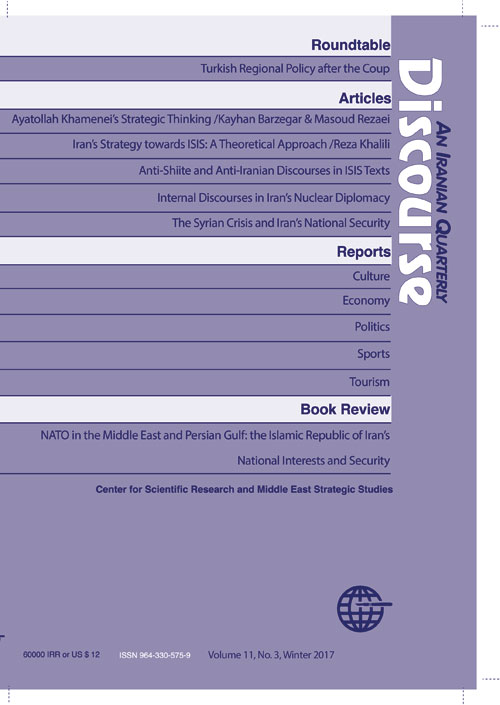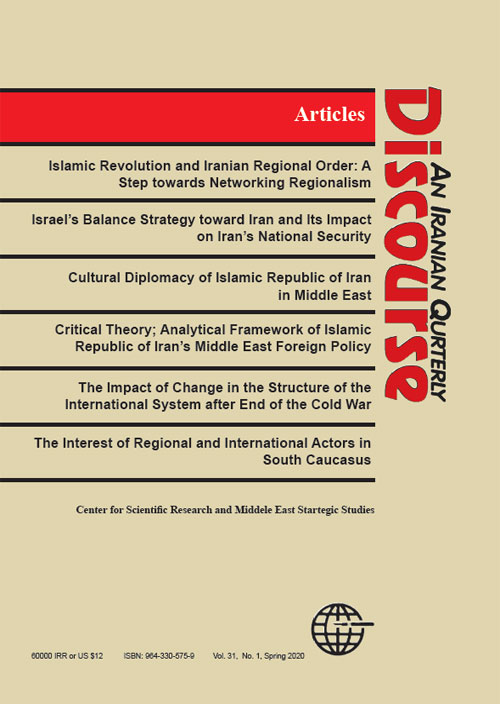فهرست مطالب

DIscourse
Volume:11 Issue: 3, Winter 2017
- تاریخ انتشار: 1396/04/25
- تعداد عناوین: 13
-
Page 27What is Ayatollah Khameneis strategic thinking, and how does it shape and influence Irans foreign policy, military and national security strategy? This article studies the theoretical and conceptual dimensions of Ayatollah Khameneis foreign policy and strategic thinking, including his aims and principles, approaches, behaviors, decisions, and incentives, as the Islamic Republic of Irans commander-in-chief of armed forces. The authors strive to explain how the political and military doctrine of Irans Supreme Leader is designed to increase the countrys relative security. They argue that Irans leader tries to neutralize challenges caused by new changes that have occurred in Irans immediate security sphere through activating patterns related to active deterrence. Thus, for him, sufficient military power can only be obtained by maximizing security. This way of thinking can best be explained by defensive realism theory. In this context, four dimensions of this theory i.e., balance of power, balance of threat, interconnected security, and offense-defense approach are discussed in the thoughts of Irans leader. The authors also hold that the ethical aspect of Ayatollah Khameneis strategic thinking, based on the principles of Islamic international relations, gives realism in the Middle East a critical approach.Keywords: Ayatollah Khamenei, Iran's National Security, Defensive Realism, Relative Security, Balance of Power, Offense-Defense Approach
-
Page 55What are the theoretical perspectives on ways of confronting ISIS? Which of them can be the basis of Irans strategy towards this group? The inhumane and violent behaviors of ISIS, the so-called Islamic State or Daesh, have made people of many countries in the region and around the world shocked and full of hatred to the extent that societies and politicians of different countries, including Iran, have explicitly opposed it. Thus far, the issue of confronting the ISIS threats has been undertaken more practically. Using a theoretical context, the author of this article holds that Iran can effectively fight against ISIS by relying on a strategic approach which may be performed by concentrating on strategic Islam or civilization-making aspect of Islam (manifested in an Islamic Awakening), and its cooperation with a Western strategic layer (forming an international coalition). It is also necessary for this kind of confrontation to be comprehensive enough to include all other approaches within itself and to be operationalized.Keywords: ISIS, Theoretical Approaches, Strategic Approach, Iran, International Coalition, International Actors
-
Page 75This article investigates how Shiaphobia and anti-Iranianism are constructed in the ISIS (Daesh) discourse. The author applies critical discourse analysis to understand how Shiaphobia and anti-Iranianism are shaped in ISIS media. The article also seeks to demonstrate that anti-Shiism has always existed throughout the history of Islam, and has grown due to the present conditions in Iraq and Syria, due to an increase in Irans relative power. This is also due to having a preexisting foundation in Salafi discourse (including, but not limited to, tribalism and sectarianism in the Arabian Peninsula, a background of takfiri jurisprudence, and a reaction to modernity and its symbols) has now resulted in shaping ISIS discourse, which defines Shia and Iranian identity as a common entity, as its enemy. In fact, ISIS identity, which in and of itself is a sum of different sources of subjective structures, plays a determining role in this groups orientation through its interactions with the outside world. ISIS seeks to justify and legitimize such behaviors, specially its behavior toward Shiites as the other and immediate enemy. The author concludes that ISIS discourse conflates the Shia with Iran and homogenizes the concepts related to Shia and Iran, stimulating ISIS animosity toward Iran and Shiites.Keywords: ISIS Discourse, Critical Discourse Analysis, Shia, Anti-Iranian Discourse of ISIS, ISIS Texts
-
Page 97This article investigates the effects of Irans internal political discourses on how political events were conducted during nuclear negotiations in the period between 2013 and 2015. The author holds that due to its emphasis on de-escalation and political development, the reformist discourse opposed challenging progress in nuclear technology. In contrast, the principlist camp has seen nuclear energy as a symbol of opposition and resistance against the West. Due to their emphasis on economic development and cooperation with the world system, the moderate camp also agreed on trust building with the West in order to resolve the nuclear problem. To examine the aforementioned argument, the author investigated different ways of thinking of Irans main parties in the countrys foreign policy based on discourse theory. The author also evaluates the performance of these discourses in Irans nuclear negotiations. Irans nuclear case resulted mainly in a relationship made between domestic policy and foreign policy. Meanwhile, the ups and downs of Irans nuclear case have challenged the arrangement of its internal politics. In other words, it created a gap between President Hassan Rouhanis moderate camp and the principalist camp, brought some principlists closer to the moderates, and created a gap among the principlists itself. The author concludes that the nuclear standoff turned the right and left disagreement into disagreement between the proponents and opponents with the JCPOA in Irans policy and recreated a new left and right in Irans domestic politics.Keywords: Discourse, Reformists, Principlists, Moderation, Nuclear Negotiations, JCPOA
-
Page 113This article studies probable scenarios for the future of the Syrian crisis and that how they influence the national security and interest of Iran in the Middle East. These scenarios may include the fall of Bashar AlAssads government and the empowerment of extremists, reestablishment of Bashar Al-Assads control in Syria, and continuation of the war situation in Syria and disintegration of the country. In addition, the authors of this article propose a possible political solution as the prospective scenario for the Syrian crisis. In this respect, they believe that the security of Iran in the Middle East and in the long term will only be preserved by finding a comprehensive political solution to the Syrian crisis. Finally, the authors conclude that the realization of a political solution depends on the willpower of Bashar Al-Assads opponents and proponents on all the three internal, regional and international levels to put an end to the crisis. In this regard, the UN can play a useful role as a mediator of the various viewpoints of the concerned parties.Keywords: Scenario Planning, Syrian Crisis, Syrian Opposition Groups, Regional States, Trans-regional States, Iran's National Security
-
Page 131
-
Page 135
-
Page 140
-
Page 150
-
Page 152


